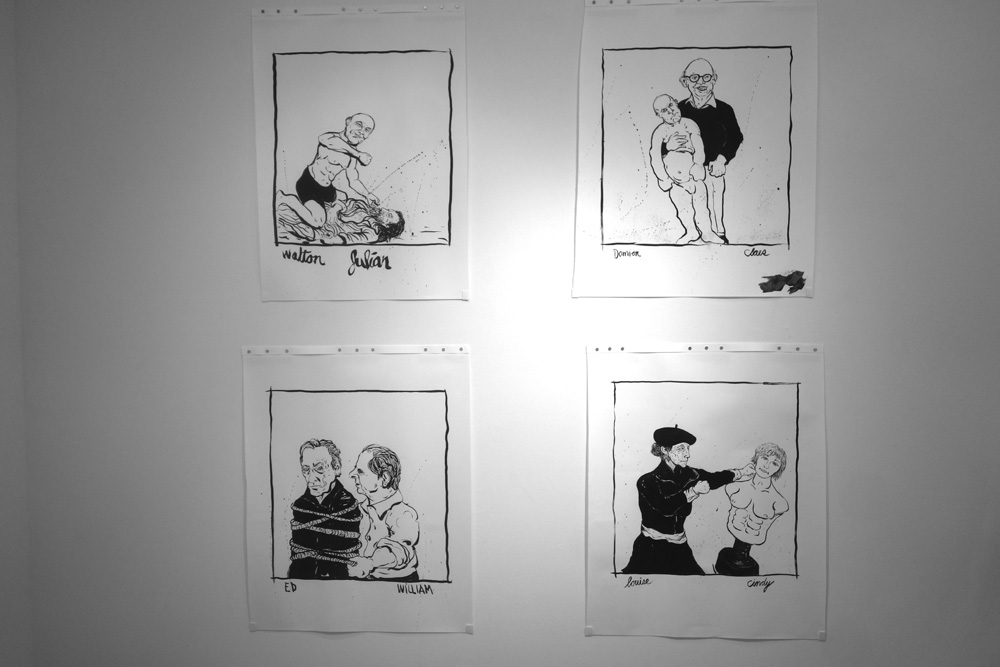
We got to know Rick Hock a little at a time. Steve the mailman would talk about him as “another music nut,” someone we should know. Rick lived the next block over, on Barry Street. My cousin lived on that street too and we never saw her. Steve used our bathroom because we worked out of the house. He’d bring us cookies that the ladies at Elite Bakery would give him when he delivered their mail and he always had the new Neil Young record on the day it came out because he friends with Kim at the House of Guitars. Steve kept telling us “we had to meet this guy.”
We met Rick’s wife first and she offered us a kitten, one born to a scraggily white cat that lived under their house. Stella, who is solid white like her mother, is seventeen now and a real sweetheart. Every time we saw Rick we’d tell him, “we still have that cat.”
Rick was someone you wanted to get to know. He was intriguing and opened himself slowly so that each encounter was an adventure. He played guitar and jammed with Peggi and me in our neighbors’ (Willie and Ethylene’s) driveway while they were having a garage sale. Rick was an artist and he converted the attic in his house into his studio. He worked at the Eastman House and curated some of our favorite shows there.
Rick was dark and sweet at the same time. He was very bitter about the Vietnam Nam war and it didn’t take much to get him going on politics. He was frustrated about a lot of things but always looking for an opening or a way to express the madness. The last few times we saw him were heartbreaking as we learned he had cancer. He died when he was on a roll.

His drawings, on display now in the small gallery at RoCo, are explosive. I hear these are some of the last things he did so the show was put together without Rick’s guidance. The large drawings portray pairs of artists locked in battles. Joseph Bueys beating up on Warhol etc. RoCo has made these pairs out to be winners and losers, favorite artists putting posers in their place, but I like to think they just portray the struggle, to make art, to create, to be successful in the market or true to the creative gods. Artists vs. art.
There are ten of them here, even one that Rick didn’t title which RoCo has turned into a contest to identify. I cast my vote and am pretty sure I have the answer.
Bruce Nauman, Kara Walker, Anselm Kiefer, Francis Bacon, Joseph Beuys, Walton Ford, Claes Oldenburg, William Kentridge, Louise Bourgeois, Andres Serrano Tracey Emin, Jeff Koons, Elizabeth Peyton, Andy Warhol, Jackson Pollock, Julian Schnabel, Damien Hirst, Ed Ruscha and Cindy Sherman are all there. Don’t miss this show.
Here’s the Meredith Davenport’ statement that accompanies the show:
“Drawing was a fluid way for Rick McKee Hock to metabolize ideas and to connect with people, whether he was sketching his frustrations out in a meeting or sharing complex feelings through the loving marks on a birthday card, it was the process of drawing that was a primary connection to the world around him. His fascination with the mark and to visual language combined with his intellectual complexity would move him towards the photographic images he is so well respected for.
But the drawings are essential. They are artifacts of the conversations he was having with the world- sometimes profound, occasionally banal and most times they were very funny. A few times they were also terrifyingly prescient. He struggled with the limitations of his drawings. Were these “cartoons”, truncated one-liners that could not transcend into the deeper things he felt and observed and tried to express? How could he imbue these marks with more? It was a constant struggle for him because he loved the mark and the paper and the pen even more than the silver image.
Like many artists before him, Rick located himself in the creative cosmos through the artists he admired and he made reference to them in his work. Maybe it was a way for him to commune with their ideas or to pay homage to the impact they had on him? He made an early set of small engravings of photographers he respected and his polaroid works reference writers like Ezra Pound and William S. Burroughs. In these drawings, he was into deeper questions about contemporary art through narratives he created via the artists he admired and hated. The marks and humor were a way for him to think about and distill their work and their careers. They are a beautiful expression of his own labor to resolve the tensmn between his big brain and his skilled and intuitive hand.
For me these drawings are also a love letter. When he made them, I was in New York City taking two‐week drawing course at the Studio School. Each night, after eight hours of classical figure drawing, I would receive a photograph on my cell phone of one of these drawings that he made during the day. It was his way to be with me. He knew that I also battle with similar questions in the contemporary art dialog. He worked with artists I admired like Louise Bourgeois and Bruce Nauman. In his drawings their authenticity always defeated the charlatans. We were somehow all in this fight together!”
– Meredith Davenport
